动手学深度学习Pytorch Task04
本节课主要内容为机器翻译及相关技术、注意力机制与Seq2seq模型、Transformer
一、机器翻译及相关技术机器翻译:将一段文本从一种语言自动翻译为另一种语言,用神经网络解决这个问题通常称为神经机器翻译。 主要特征:输出是单词序列而不是单个单词。 输出序列的长度可能与源序列的长度不同。
导入库import os
os.listdir('/home/kesci/input/')
import sys
sys.path.append('/home/kesci/input/d2l9528/')
import collections
import d2l
import zipfile
from d2l.data.base import Vocab
import time
import torch
import torch.nn as nn
import torch.nn.functional as F
from torch.utils import data
from torch import optim
数据预处理
读入数据集
with open('/home/kesci/input/fraeng6506/fra.txt', 'r') as f:
raw_text = f.read()
print(raw_text[0:1000])
输出结果
Go. Va ! CC-BY 2.0 (France) Attribution: tatoeba.org #2877272 (CM) & #1158250 (Wittydev)
Hi. Salut ! CC-BY 2.0 (France) Attribution: tatoeba.org #538123 (CM) & #509819 (Aiji)
Hi. Salut. CC-BY 2.0 (France) Attribution: tatoeba.org #538123 (CM) & #4320462 (gillux)
Run! Cours ! CC-BY 2.0 (France) Attribution: tatoeba.org #906328 (papabear) & #906331 (sacredceltic)
Run! Courez ! CC-BY 2.0 (France) Attribution: tatoeba.org #906328 (papabear) & #906332 (sacredceltic)
Who? Qui ? CC-BY 2.0 (France) Attribution: tatoeba.org #2083030 (CK) & #4366796 (gillux)
Wow! Ça alors ! CC-BY 2.0 (France) Attribution: tatoeba.org #52027 (Zifre) & #374631 (zmoo)
Fire! Au feu ! CC-BY 2.0 (France) Attribution: tatoeba.org #1829639 (Spamster) & #4627939 (sacredceltic)
Help! À l'aide ! CC-BY 2.0 (France) Attribution: tatoeba.org #435084 (lukaszpp) & #128430 (sysko)
Jump. Saute. CC-BY 2.0 (France) Attribution: tatoeba.org #631038 (Shishir) & #2416938 (Phoenix)
Stop! Ça suffit ! CC-BY 2.0 (France) Attribution: tato
预处理
字符在计算机里是以编码的形式存在,我们通常所用的空格是 \x20 ,是在标准ASCII可见字符 0x20~0x7e 范围内。 而 \xa0 属于 latin1 (ISO/IEC_8859-1)中的扩展字符集字符,代表不间断空白符nbsp(non-breaking space),超出gbk编码范围,是需要去除的特殊字符。再数据预处理的过程中,我们首先需要对数据进行清洗。
def preprocess_raw(text):
text = text.replace('\u202f', ' ').replace('\xa0', ' ') # 去除乱码
out = ''
for i, char in enumerate(text.lower()): # 大小写转换
if char in (',', '!', '.') and i > 0 and text[i-1] != ' ': # 单词和标点符号间添加空格
out += ' '
out += char
return out
text = preprocess_raw(raw_text)
print(text[0:1000])
输出结果
go . va ! cc-by 2 .0 (france) attribution: tatoeba .org #2877272 (cm) & #1158250 (wittydev)
hi . salut ! cc-by 2 .0 (france) attribution: tatoeba .org #538123 (cm) & #509819 (aiji)
hi . salut . cc-by 2 .0 (france) attribution: tatoeba .org #538123 (cm) & #4320462 (gillux)
run ! cours ! cc-by 2 .0 (france) attribution: tatoeba .org #906328 (papabear) & #906331 (sacredceltic)
run ! courez ! cc-by 2 .0 (france) attribution: tatoeba .org #906328 (papabear) & #906332 (sacredceltic)
who? qui ? cc-by 2 .0 (france) attribution: tatoeba .org #2083030 (ck) & #4366796 (gillux)
wow ! ça alors ! cc-by 2 .0 (france) attribution: tatoeba .org #52027 (zifre) & #374631 (zmoo)
fire ! au feu ! cc-by 2 .0 (france) attribution: tatoeba .org #1829639 (spamster) & #4627939 (sacredceltic)
help ! à l'aide ! cc-by 2 .0 (france) attribution: tatoeba .org #435084 (lukaszpp) & #128430 (sysko)
jump . saute . cc-by 2 .0 (france) attribution: tatoeba .org #631038 (shishir) & #2416938 (phoenix)
stop ! ça suffit ! cc-b
分词
num_examples = 50000
source, target = [], []
for i, line in enumerate(text.split('\n')): # 按照空格划分
if i > num_examples:
break
parts = line.split('\t') # 按照制表符划分,得到前两个单词
if len(parts) >= 2:
source.append(parts[0].split(' '))
target.append(parts[1].split(' '))
source[0:3], target[0:3]
([['go', '.'], ['hi', '.'], ['hi', '.']],
[['va', '!'], ['salut', '!'], ['salut', '.']])
建立词典
def build_vocab(tokens):
tokens = [token for line in tokens for token in line]
return d2l.data.base.Vocab(tokens, min_freq=3, use_special_tokens=True)
src_vocab = build_vocab(source)
载入数据集
def pad(line, max_len, padding_token):
'''
用来做padding
'''
if len(line) > max_len:
return line[:max_len]
return line + [padding_token] * (max_len - len(line))
def build_array(lines, vocab, max_len, is_source):
'''
将单词表对应为tensor,返回对应的列表和有效长度即padding前长度
'''
lines = [vocab[line] for line in lines]
if not is_source:
lines = [[vocab.bos] + line + [vocab.eos] for line in lines]
array = torch.tensor([pad(line, max_len, vocab.pad) for line in lines])
valid_len = (array != vocab.pad).sum(1) #第一个维度
return array, valid_len
def load_data_nmt(batch_size, max_len): # This function is saved in d2l.
src_vocab, tgt_vocab = build_vocab(source), build_vocab(target)
src_array, src_valid_len = build_array(source, src_vocab, max_len, True)
tgt_array, tgt_valid_len = build_array(target, tgt_vocab, max_len, False)
train_data = data.TensorDataset(src_array, src_valid_len, tgt_array, tgt_valid_len)
train_iter = data.DataLoader(train_data, batch_size, shuffle=True)
return src_vocab, tgt_vocab, train_iter
src_vocab, tgt_vocab, train_iter = load_data_nmt(batch_size=2, max_len=8)
Encoder-Decoder结构
encoder:输入到隐藏状态
decoder:隐藏状态到输出

class Encoder(nn.Module):
def __init__(self, **kwargs):
super(Encoder, self).__init__(**kwargs)
def forward(self, X, *args):
raise NotImplementedError
class Decoder(nn.Module):
def __init__(self, **kwargs):
super(Decoder, self).__init__(**kwargs)
def init_state(self, enc_outputs, *args):
raise NotImplementedError
def forward(self, X, state):
raise NotImplementedError
Sequence to Sequence模型
Sequence to Sequence模型一种Encoder-Decode结构,模型如下:
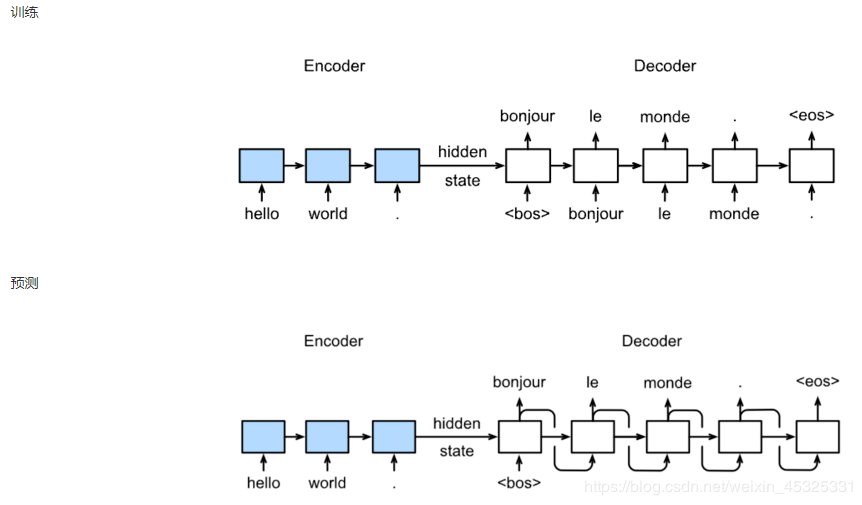
具体结构:

class Seq2SeqEncoder(d2l.Encoder):
def __init__(self, vocab_size, embed_size, num_hiddens, num_layers,
dropout=0, **kwargs):
super(Seq2SeqEncoder, self).__init__(**kwargs)
self.num_hiddens=num_hiddens
self.num_layers=num_layers
self.embedding = nn.Embedding(vocab_size, embed_size)
self.rnn = nn.LSTM(embed_size,num_hiddens, num_layers, dropout=dropout)
def begin_state(self, batch_size, device):
return [torch.zeros(size=(self.num_layers, batch_size, self.num_hiddens), device=device),
torch.zeros(size=(self.num_layers, batch_size, self.num_hiddens), device=device)]
def forward(self, X, *args):
X = self.embedding(X) # X shape: (batch_size, seq_len, embed_size)
X = X.transpose(0, 1) # RNN needs first axes to be time
# state = self.begin_state(X.shape[1], device=X.device)
out, state = self.rnn(X)
# The shape of out is (seq_len, batch_size, num_hiddens).
# state contains the hidden state and the memory cell
# of the last time step, the shape is (num_layers, batch_size, num_hiddens)
return out, state
Decoder
class Seq2SeqDecoder(d2l.Decoder):
def __init__(self, vocab_size, embed_size, num_hiddens, num_layers,
dropout=0, **kwargs):
super(Seq2SeqDecoder, self).__init__(**kwargs)
self.embedding = nn.Embedding(vocab_size, embed_size)
self.rnn = nn.LSTM(embed_size,num_hiddens, num_layers, dropout=dropout)
self.dense = nn.Linear(num_hiddens,vocab_size)
def init_state(self, enc_outputs, *args):
return enc_outputs[1]
def forward(self, X, state):
X = self.embedding(X).transpose(0, 1)
out, state = self.rnn(X, state)
# Make the batch to be the first dimension to simplify loss computation.
out = self.dense(out).transpose(0, 1)
return out, state
损失函数
由于使用了padding结构,所以损失函数需要在原本的CrossEntropy上进行修改,首先用SequenceMask函数确定有效位数再计算loss
def SequenceMask(X, X_len,value=0):
maxlen = X.size(1)
mask = torch.arange(maxlen)[None, :].to(X_len.device) < X_len[:, None]
X[~mask]=value
return X
class MaskedSoftmaxCELoss(nn.CrossEntropyLoss):
# pred shape: (batch_size, seq_len, vocab_size)
# label shape: (batch_size, seq_len)
# valid_length shape: (batch_size, )
def forward(self, pred, label, valid_length):
# the sample weights shape should be (batch_size, seq_len)
weights = torch.ones_like(label)
weights = SequenceMask(weights, valid_length).float()
self.reduction='none'
output=super(MaskedSoftmaxCELoss, self).forward(pred.transpose(1,2), label)
return (output*weights).mean(dim=1)
训练
def train_ch7(model, data_iter, lr, num_epochs, device): # Saved in d2l
model.to(device)
optimizer = optim.Adam(model.parameters(), lr=lr)
loss = MaskedSoftmaxCELoss()
tic = time.time()
for epoch in range(1, num_epochs+1):
l_sum, num_tokens_sum = 0.0, 0.0
for batch in data_iter:
optimizer.zero_grad()
X, X_vlen, Y, Y_vlen = [x.to(device) for x in batch]
Y_input, Y_label, Y_vlen = Y[:,:-1], Y[:,1:], Y_vlen-1
Y_hat, _ = model(X, Y_input, X_vlen, Y_vlen)
l = loss(Y_hat, Y_label, Y_vlen).sum()
l.backward()
with torch.no_grad():
d2l.grad_clipping_nn(model, 5, device)
num_tokens = Y_vlen.sum().item()
optimizer.step()
l_sum += l.sum().item()
num_tokens_sum += num_tokens
if epoch % 50 == 0:
print("epoch {0:4d},loss {1:.3f}, time {2:.1f} sec".format(
epoch, (l_sum/num_tokens_sum), time.time()-tic))
tic = time.time()
embed_size, num_hiddens, num_layers, dropout = 32, 32, 2, 0.0
batch_size, num_examples, max_len = 64, 1e3, 10
lr, num_epochs, ctx = 0.005, 300, d2l.try_gpu()
src_vocab, tgt_vocab, train_iter = d2l.load_data_nmt(
batch_size, max_len,num_examples)
encoder = Seq2SeqEncoder(
len(src_vocab), embed_size, num_hiddens, num_layers, dropout)
decoder = Seq2SeqDecoder(
len(tgt_vocab), embed_size, num_hiddens, num_layers, dropout)
model = d2l.EncoderDecoder(encoder, decoder)
train_ch7(model, train_iter, lr, num_epochs, ctx)
测试
def translate_ch7(model, src_sentence, src_vocab, tgt_vocab, max_len, device):
src_tokens = src_vocab[src_sentence.lower().split(' ')]
src_len = len(src_tokens)
if src_len ' + translate_ch7(
model, sentence, src_vocab, tgt_vocab, max_len, ctx))
Beam Search
集束搜索每次找出预测概率最大的n个单词来代替原本选择概率最高的那个单词。
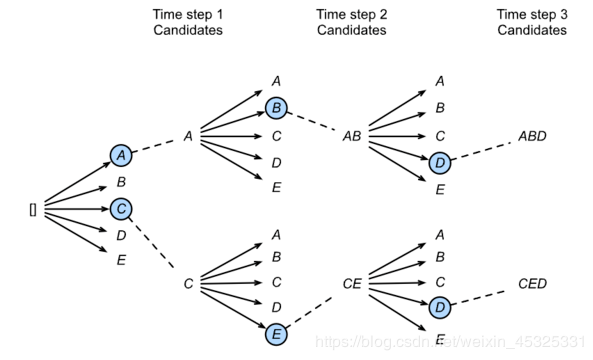
在“编码器—解码器(seq2seq)”一节中,解码器在各个时间步依赖相同的背景变量(context vector)来获取输入序列信息。当编码器为循环神经网络时,背景变量来用它最终时间步的隐藏状态。将源序列输入信息以循环单位状态编码,然后将其传递给解码器以生成目标序列。然而这种结构存在着问题,尤其是RNN机制实际中存在长程梯度消失的问题,对于较长的句子,我们很难寄希望于将输入的序列转化为定长的向量而保存所有的有效信息,所以随着所需翻译句子的长度的增加,这种结构的效果会显著下降。
与此同时,解码的目标词语可能只与原输入的部分词语有关,而并不是与所有的输入有关。例如,当把“Hello world”翻译成“Bonjour le monde”时,“Hello”映射成“Bonjour”,“world”映射成“monde”。在seq2seq模型中,解码器只能隐式地从编码器的最终状态中选择相应的信息。然而,注意力机制可以将这种选择过程显式地建模。
注意力机制框架Attention 是一种通用的带权池化方法,输入由两部分构成:询问(query)和键值对(key-value pairs)。 attention layer得到输出与value的维度一致。 对于一个query来说,attention layer 会与每一个key计算注意力分数并进行权重的归一化,输出的向量则是value的加权求和,而每个key计算的权重与value一一对应。
为了计算输出,我们首先假设有一个函数用于计算query和key的相似性,然后可以计算所有的 attention scores。

我们使用 softmax函数 获得注意力权重:

最终的输出就是value的加权求和:
![]()
不同的attetion layer的区别在于score函数的选择,在本节的其余部分,我们将讨论两个常用的注意层 Dot-product Attention 和 Multilayer Perceptron Attention;随后我们将实现一个引入attention的seq2seq模型并在英法翻译语料上进行训练与测试。
import math
import torch
import torch.nn as nn
import os
def file_name_walk(file_dir):
for root, dirs, files in os.walk(file_dir):
# print("root", root) # 当前目录路径
print("dirs", dirs) # 当前路径下所有子目录
print("files", files) # 当前路径下所有非目录子文件
file_name_walk("/home/kesci/input/fraeng6506")
softmax屏蔽
def SequenceMask(X, X_len,value=-1e6):
maxlen = X.size(1)
#print(X.size(),torch.arange((maxlen),dtype=torch.float)[None, :],'\n',X_len[:, None] )
mask = torch.arange((maxlen),dtype=torch.float)[None, :] >= X_len[:, None]
#print(mask)
X[mask]=value
return X
def masked_softmax(X, valid_length):
# X: 3-D tensor, valid_length: 1-D or 2-D tensor
softmax = nn.Softmax(dim=-1)
if valid_length is None:
return softmax(X)
else:
shape = X.shape
if valid_length.dim() == 1:
try:
valid_length = torch.FloatTensor(valid_length.numpy().repeat(shape[1], axis=0))#[2,2,3,3]
except:
valid_length = torch.FloatTensor(valid_length.cpu().numpy().repeat(shape[1], axis=0))#[2,2,3,3]
else:
valid_length = valid_length.reshape((-1,))
# fill masked elements with a large negative, whose exp is 0
X = SequenceMask(X.reshape((-1, shape[-1])), valid_length)
return softmax(X).reshape(shape)
点积注意力

class DotProductAttention(nn.Module):
def __init__(self, dropout, **kwargs):
super(DotProductAttention, self).__init__(**kwargs)
self.dropout = nn.Dropout(dropout)
# query: (batch_size, #queries, d)
# key: (batch_size, #kv_pairs, d)
# value: (batch_size, #kv_pairs, dim_v)
# valid_length: either (batch_size, ) or (batch_size, xx)
def forward(self, query, key, value, valid_length=None):
d = query.shape[-1]
# set transpose_b=True to swap the last two dimensions of key
scores = torch.bmm(query, key.transpose(1,2)) / math.sqrt(d)
attention_weights = self.dropout(masked_softmax(scores, valid_length))
print("attention_weight\n",attention_weights)
return torch.bmm(attention_weights, value)
多层感知机注意力

# Save to the d2l package.
class MLPAttention(nn.Module):
def __init__(self, units,ipt_dim,dropout, **kwargs):
super(MLPAttention, self).__init__(**kwargs)
# Use flatten=True to keep query's and key's 3-D shapes.
self.W_k = nn.Linear(ipt_dim, units, bias=False)
self.W_q = nn.Linear(ipt_dim, units, bias=False)
self.v = nn.Linear(units, 1, bias=False)
self.dropout = nn.Dropout(dropout)
def forward(self, query, key, value, valid_length):
query, key = self.W_k(query), self.W_q(key)
#print("size",query.size(),key.size())
# expand query to (batch_size, #querys, 1, units), and key to
# (batch_size, 1, #kv_pairs, units). Then plus them with broadcast.
features = query.unsqueeze(2) + key.unsqueeze(1)
#print("features:",features.size()) #--------------开启
scores = self.v(features).squeeze(-1)
attention_weights = self.dropout(masked_softmax(scores, valid_length))
return torch.bmm(attention_weights, value)
引入注意力机制的Seq2seq模型
本节中将注意机制添加到sequence to sequence 模型中,以显式地使用权重聚合states。下图展示encoding 和decoding的模型结构,在时间步为t的时候。此刻attention layer保存着encodering看到的所有信息——即encoding的每一步输出。在decoding阶段,解码器的时刻的隐藏状态被当作query,encoder的每个时间步的hidden states作为key和value进行attention聚合. Attetion model的输出当作成上下文信息context vector,并与解码器输入拼接起来一起送到解码器:

下图展示了seq2seq机制的所以层的关系,下面展示了encoder和decoder的layer结构
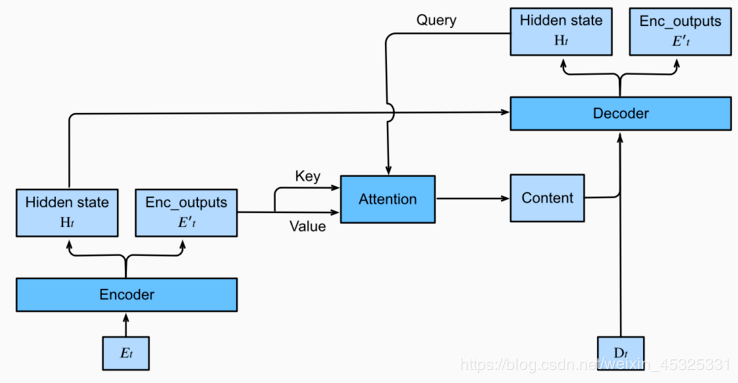
由于带有注意机制的seq2seq的编码器与之前章节中的Seq2SeqEncoder相同,所以在此处我们只关注解码器。我们添加了一个MLP注意层(MLPAttention),它的隐藏大小与解码器中的LSTM层相同。然后我们通过从编码器传递三个参数来初始化解码器的状态:
1.the encoder outputs of all timesteps:encoder输出的各个状态,被用于attetion layer的memory部分,有相同的key和values
2.the hidden state of the encoder’s final timestep:编码器最后一个时间步的隐藏状态,被用于初始化decoder 的hidden state
3.the encoder valid length: 编码器的有效长度,借此,注意层不会考虑编码器输出中的填充标记(Paddings)
在解码的每个时间步,我们使用解码器的最后一个RNN层的输出作为注意层的query。然后,将注意力模型的输出与输入嵌入向量连接起来,输入到RNN层。虽然RNN层隐藏状态也包含来自解码器的历史信息,但是attention model的输出显式地选择了enc_valid_len以内的编码器输出,这样attention机制就会尽可能排除其他不相关的信息。
class Seq2SeqAttentionDecoder(d2l.Decoder):
def __init__(self, vocab_size, embed_size, num_hiddens, num_layers,
dropout=0, **kwargs):
super(Seq2SeqAttentionDecoder, self).__init__(**kwargs)
self.attention_cell = MLPAttention(num_hiddens,num_hiddens, dropout)
self.embedding = nn.Embedding(vocab_size, embed_size)
self.rnn = nn.LSTM(embed_size+ num_hiddens,num_hiddens, num_layers, dropout=dropout)
self.dense = nn.Linear(num_hiddens,vocab_size)
def init_state(self, enc_outputs, enc_valid_len, *args):
outputs, hidden_state = enc_outputs
# print("first:",outputs.size(),hidden_state[0].size(),hidden_state[1].size())
# Transpose outputs to (batch_size, seq_len, hidden_size)
return (outputs.permute(1,0,-1), hidden_state, enc_valid_len)
#outputs.swapaxes(0, 1)
def forward(self, X, state):
enc_outputs, hidden_state, enc_valid_len = state
#("X.size",X.size())
X = self.embedding(X).transpose(0,1)
# print("Xembeding.size2",X.size())
outputs = []
for l, x in enumerate(X):
# print(f"\n{l}-th token")
# print("x.first.size()",x.size())
# query shape: (batch_size, 1, hidden_size)
# select hidden state of the last rnn layer as query
query = hidden_state[0][-1].unsqueeze(1) # np.expand_dims(hidden_state[0][-1], axis=1)
# context has same shape as query
# print("query enc_outputs, enc_outputs:\n",query.size(), enc_outputs.size(), enc_outputs.size())
context = self.attention_cell(query, enc_outputs, enc_outputs, enc_valid_len)
# Concatenate on the feature dimension
# print("context.size:",context.size())
x = torch.cat((context, x.unsqueeze(1)), dim=-1)
# Reshape x to (1, batch_size, embed_size+hidden_size)
# print("rnn",x.size(), len(hidden_state))
out, hidden_state = self.rnn(x.transpose(0,1), hidden_state)
outputs.append(out)
outputs = self.dense(torch.cat(outputs, dim=0))
return outputs.transpose(0, 1), [enc_outputs, hidden_state,
enc_valid_len]
现在我们可以用注意力模型来测试seq2seq。为了与第9.7节中的模型保持一致,我们对vocab_size、embed_size、num_hiddens和num_layers使用相同的超参数。结果,我们得到了相同的解码器输出形状,但是状态结构改变了。
encoder = d2l.Seq2SeqEncoder(vocab_size=10, embed_size=8,
num_hiddens=16, num_layers=2)
# encoder.initialize()
decoder = Seq2SeqAttentionDecoder(vocab_size=10, embed_size=8,
num_hiddens=16, num_layers=2)
X = torch.zeros((4, 7),dtype=torch.long)
print("batch size=4\nseq_length=7\nhidden dim=16\nnum_layers=2\n")
print('encoder output size:', encoder(X)[0].size())
print('encoder hidden size:', encoder(X)[1][0].size())
print('encoder memory size:', encoder(X)[1][1].size())
state = decoder.init_state(encoder(X), None)
out, state = decoder(X, state)
out.shape, len(state), state[0].shape, len(state[1]), state[1][0].shape
训练
import zipfile
import torch
import requests
from io import BytesIO
from torch.utils import data
import sys
import collections
class Vocab(object): # This class is saved in d2l.
def __init__(self, tokens, min_freq=0, use_special_tokens=False):
# sort by frequency and token
counter = collections.Counter(tokens)
token_freqs = sorted(counter.items(), key=lambda x: x[0])
token_freqs.sort(key=lambda x: x[1], reverse=True)
if use_special_tokens:
# padding, begin of sentence, end of sentence, unknown
self.pad, self.bos, self.eos, self.unk = (0, 1, 2, 3)
tokens = ['', '', '', '']
else:
self.unk = 0
tokens = ['']
tokens += [token for token, freq in token_freqs if freq >= min_freq]
self.idx_to_token = []
self.token_to_idx = dict()
for token in tokens:
self.idx_to_token.append(token)
self.token_to_idx[token] = len(self.idx_to_token) - 1
def __len__(self):
return len(self.idx_to_token)
def __getitem__(self, tokens):
if not isinstance(tokens, (list, tuple)):
return self.token_to_idx.get(tokens, self.unk)
else:
return [self.__getitem__(token) for token in tokens]
def to_tokens(self, indices):
if not isinstance(indices, (list, tuple)):
return self.idx_to_token[indices]
else:
return [self.idx_to_token[index] for index in indices]
def load_data_nmt(batch_size, max_len, num_examples=1000):
"""Download an NMT dataset, return its vocabulary and data iterator."""
# Download and preprocess
def preprocess_raw(text):
text = text.replace('\u202f', ' ').replace('\xa0', ' ')
out = ''
for i, char in enumerate(text.lower()):
if char in (',', '!', '.') and text[i-1] != ' ':
out += ' '
out += char
return out
with open('/home/kesci/input/fraeng6506/fra.txt', 'r') as f:
raw_text = f.read()
text = preprocess_raw(raw_text)
# Tokenize
source, target = [], []
for i, line in enumerate(text.split('\n')):
if i >= num_examples:
break
parts = line.split('\t')
if len(parts) >= 2:
source.append(parts[0].split(' '))
target.append(parts[1].split(' '))
# Build vocab
def build_vocab(tokens):
tokens = [token for line in tokens for token in line]
return Vocab(tokens, min_freq=3, use_special_tokens=True)
src_vocab, tgt_vocab = build_vocab(source), build_vocab(target)
# Convert to index arrays
def pad(line, max_len, padding_token):
if len(line) > max_len:
return line[:max_len]
return line + [padding_token] * (max_len - len(line))
def build_array(lines, vocab, max_len, is_source):
lines = [vocab[line] for line in lines]
if not is_source:
lines = [[vocab.bos] + line + [vocab.eos] for line in lines]
array = torch.tensor([pad(line, max_len, vocab.pad) for line in lines])
valid_len = (array != vocab.pad).sum(1)
return array, valid_len
src_vocab, tgt_vocab = build_vocab(source), build_vocab(target)
src_array, src_valid_len = build_array(source, src_vocab, max_len, True)
tgt_array, tgt_valid_len = build_array(target, tgt_vocab, max_len, False)
train_data = data.TensorDataset(src_array, src_valid_len, tgt_array, tgt_valid_len)
train_iter = data.DataLoader(train_data, batch_size, shuffle=True)
return src_vocab, tgt_vocab, train_iter
embed_size, num_hiddens, num_layers, dropout = 32, 32, 2, 0.0
batch_size, num_steps = 64, 10
lr, num_epochs, ctx = 0.005, 500, d2l.try_gpu()
src_vocab, tgt_vocab, train_iter = load_data_nmt(batch_size, num_steps)
encoder = d2l.Seq2SeqEncoder(
len(src_vocab), embed_size, num_hiddens, num_layers, dropout)
decoder = Seq2SeqAttentionDecoder(
len(tgt_vocab), embed_size, num_hiddens, num_layers, dropout)
model = d2l.EncoderDecoder(encoder, decoder)
d2l.train_s2s_ch9(model, train_iter, lr, num_epochs, ctx)
三、Transformer
在之前的章节中,我们已经介绍了主流的神经网络架构如卷积神经网络(CNNs)和循环神经网络(RNNs)。让我们进行一些回顾:
1.CNNs 易于并行化,却不适合捕捉变长序列内的依赖关系。
2.RNNs 适合捕捉长距离变长序列的依赖,但是却难以实现并行化处理序列。
为了整合CNN和RNN的优势,[Vaswani et al., 2017] 创新性地使用注意力机制设计了Transformer模型。该模型利用attention机制实现了并行化捕捉序列依赖,并且同时处理序列的每个位置的tokens,上述优势使得Transformer模型在性能优异的同时大大减少了训练时间。
图10.3.1展示了Transformer模型的架构,与9.7节的seq2seq模型相似,Transformer同样基于编码器-解码器架构,其区别主要在于以下三点:
1.Transformer blocks:将seq2seq模型重的循环网络替换为了Transformer Blocks,该模块包含一个多头注意力层(Multi-head Attention Layers)以及两个position-wise feed-forward networks(FFN)。对于解码器来说,另一个多头注意力层被用于接受编码器的隐藏状态。
2.Add and norm:多头注意力层和前馈网络的输出被送到两个“add and norm”层进行处理,该层包含残差结构以及层归一化。
3.Position encoding:由于自注意力层并没有区分元素的顺序,所以一个位置编码层被用于向序列元素里添加位置信息。
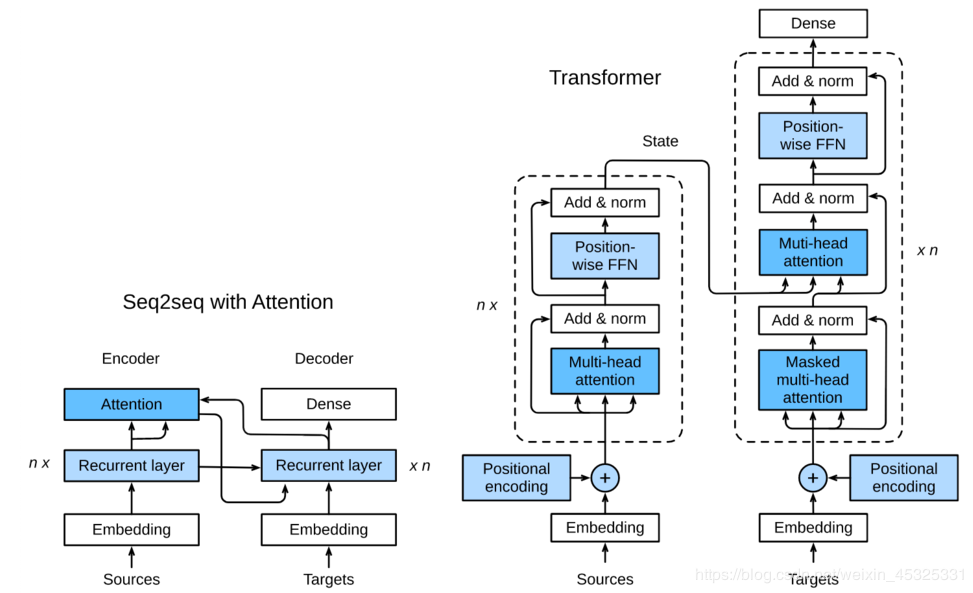
import os
import math
import numpy as np
import torch
import torch.nn as nn
import torch.nn.functional as F
import sys
sys.path.append('/home/kesci/input/d2len9900')
import d2l
#以下几个函数为上一节的内容
def SequenceMask(X, X_len,value=-1e6):
maxlen = X.size(1)
X_len = X_len.to(X.device)
#print(X.size(),torch.arange((maxlen),dtype=torch.float)[None, :],'\n',X_len[:, None] )
mask = torch.arange((maxlen), dtype=torch.float, device=X.device)
mask = mask[None, :] < X_len[:, None]
#print(mask)
X[~mask]=value
return X
def masked_softmax(X, valid_length):
# X: 3-D tensor, valid_length: 1-D or 2-D tensor
softmax = nn.Softmax(dim=-1)
if valid_length is None:
return softmax(X)
else:
shape = X.shape
if valid_length.dim() == 1:
try:
valid_length = torch.FloatTensor(valid_length.numpy().repeat(shape[1], axis=0))#[2,2,3,3]
except:
valid_length = torch.FloatTensor(valid_length.cpu().numpy().repeat(shape[1], axis=0))#[2,2,3,3]
else:
valid_length = valid_length.reshape((-1,))
# fill masked elements with a large negative, whose exp is 0
X = SequenceMask(X.reshape((-1, shape[-1])), valid_length)
return softmax(X).reshape(shape)
# Save to the d2l package.
class DotProductAttention(nn.Module):
def __init__(self, dropout, **kwargs):
super(DotProductAttention, self).__init__(**kwargs)
self.dropout = nn.Dropout(dropout)
# query: (batch_size, #queries, d)
# key: (batch_size, #kv_pairs, d)
# value: (batch_size, #kv_pairs, dim_v)
# valid_length: either (batch_size, ) or (batch_size, xx)
def forward(self, query, key, value, valid_length=None):
d = query.shape[-1]
# set transpose_b=True to swap the last two dimensions of key
scores = torch.bmm(query, key.transpose(1,2)) / math.sqrt(d)
attention_weights = self.dropout(masked_softmax(scores, valid_length))
return torch.bmm(attention_weights, value)
多头注意力层
在我们讨论多头注意力层之前,先来迅速理解以下自注意力(self-attention)的结构。自注意力模型是一个正规的注意力模型,序列的每一个元素对应的key,value,query是完全一致的。如下图自注意力输出了一个与输入长度相同的表征序列,与循环神经网络相比,自注意力对每个元素输出的计算是并行的,所以我们可以高效的实现这个模块。
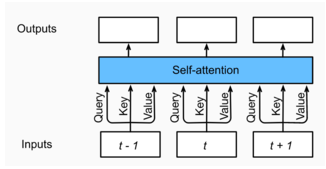
多头注意力层包含h个并行的自注意力层,每一个这种层被成为一个head。对每个头来说,在进行注意力计算之前,我们会将query、key和value用三个现行层进行映射,这h个注意力头的输出将会被拼接之后输入最后一个线性层进行整合。
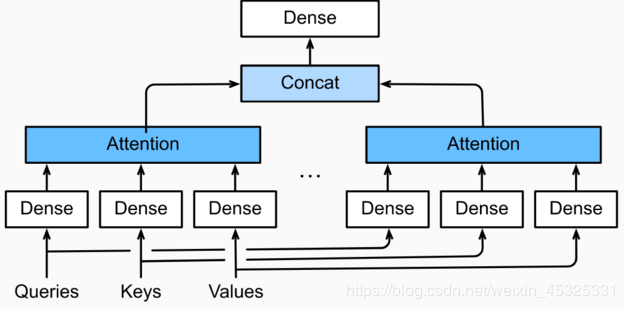

class MultiHeadAttention(nn.Module):
def __init__(self, input_size, hidden_size, num_heads, dropout, **kwargs):
super(MultiHeadAttention, self).__init__(**kwargs)
self.num_heads = num_heads
self.attention = DotProductAttention(dropout)
self.W_q = nn.Linear(input_size, hidden_size, bias=False)
self.W_k = nn.Linear(input_size, hidden_size, bias=False)
self.W_v = nn.Linear(input_size, hidden_size, bias=False)
self.W_o = nn.Linear(hidden_size, hidden_size, bias=False)
def forward(self, query, key, value, valid_length):
# query, key, and value shape: (batch_size, seq_len, dim),
# where seq_len is the length of input sequence
# valid_length shape is either (batch_size, )
# or (batch_size, seq_len).
# Project and transpose query, key, and value from
# (batch_size, seq_len, hidden_size * num_heads) to
# (batch_size * num_heads, seq_len, hidden_size).
query = transpose_qkv(self.W_q(query), self.num_heads)
key = transpose_qkv(self.W_k(key), self.num_heads)
value = transpose_qkv(self.W_v(value), self.num_heads)
if valid_length is not None:
# Copy valid_length by num_heads times
device = valid_length.device
valid_length = valid_length.cpu().numpy() if valid_length.is_cuda else valid_length.numpy()
if valid_length.ndim == 1:
valid_length = torch.FloatTensor(np.tile(valid_length, self.num_heads))
else:
valid_length = torch.FloatTensor(np.tile(valid_length, (self.num_heads,1)))
valid_length = valid_length.to(device)
output = self.attention(query, key, value, valid_length)
output_concat = transpose_output(output, self.num_heads)
return self.W_o(output_concat)
def transpose_qkv(X, num_heads):
# Original X shape: (batch_size, seq_len, hidden_size * num_heads),
# -1 means inferring its value, after first reshape, X shape:
# (batch_size, seq_len, num_heads, hidden_size)
X = X.view(X.shape[0], X.shape[1], num_heads, -1)
# After transpose, X shape: (batch_size, num_heads, seq_len, hidden_size)
X = X.transpose(2, 1).contiguous()
# Merge the first two dimensions. Use reverse=True to infer shape from
# right to left.
# output shape: (batch_size * num_heads, seq_len, hidden_size)
output = X.view(-1, X.shape[2], X.shape[3])
return output
# Saved in the d2l package for later use
def transpose_output(X, num_heads):
# A reversed version of transpose_qkv
X = X.view(-1, num_heads, X.shape[1], X.shape[2])
X = X.transpose(2, 1).contiguous()
return X.view(X.shape[0], X.shape[1], -1)
基于位置的前馈网络
Transformer 模块另一个非常重要的部分就是基于位置的前馈网络(FFN),它接受一个形状为(batch_size,seq_length, feature_size)的三维张量。Position-wise FFN由两个全连接层组成,他们作用在最后一维上。因为序列的每个位置的状态都会被单独地更新,所以我们称他为position-wise,这等效于一个1x1的卷积。
下面我们来实现PositionWiseFFN:
# Save to the d2l package.
class PositionWiseFFN(nn.Module):
def __init__(self, input_size, ffn_hidden_size, hidden_size_out, **kwargs):
super(PositionWiseFFN, self).__init__(**kwargs)
self.ffn_1 = nn.Linear(input_size, ffn_hidden_size)
self.ffn_2 = nn.Linear(ffn_hidden_size, hidden_size_out)
def forward(self, X):
return self.ffn_2(F.relu(self.ffn_1(X)))
与多头注意力层相似,FFN层同样只会对最后一维的大小进行改变;除此之外,对于两个完全相同的输入,FFN层的输出也将相等。
Add and Norm除了上面两个模块之外,Transformer还有一个重要的相加归一化层,它可以平滑地整合输入和其他层的输出,因此我们在每个多头注意力层和FFN层后面都添加一个含残差连接的Layer Norm层。这里 Layer Norm 与7.5小节的Batch Norm很相似,唯一的区别在于Batch Norm是对于batch size这个维度进行计算均值和方差的,而Layer Norm则是对最后一维进行计算。层归一化可以防止层内的数值变化过大,从而有利于加快训练速度并且提高泛化性能。
# Save to the d2l package.
class AddNorm(nn.Module):
def __init__(self, hidden_size, dropout, **kwargs):
super(AddNorm, self).__init__(**kwargs)
self.dropout = nn.Dropout(dropout)
self.norm = nn.LayerNorm(hidden_size)
def forward(self, X, Y):
return self.norm(self.dropout(Y) + X)
位置编码
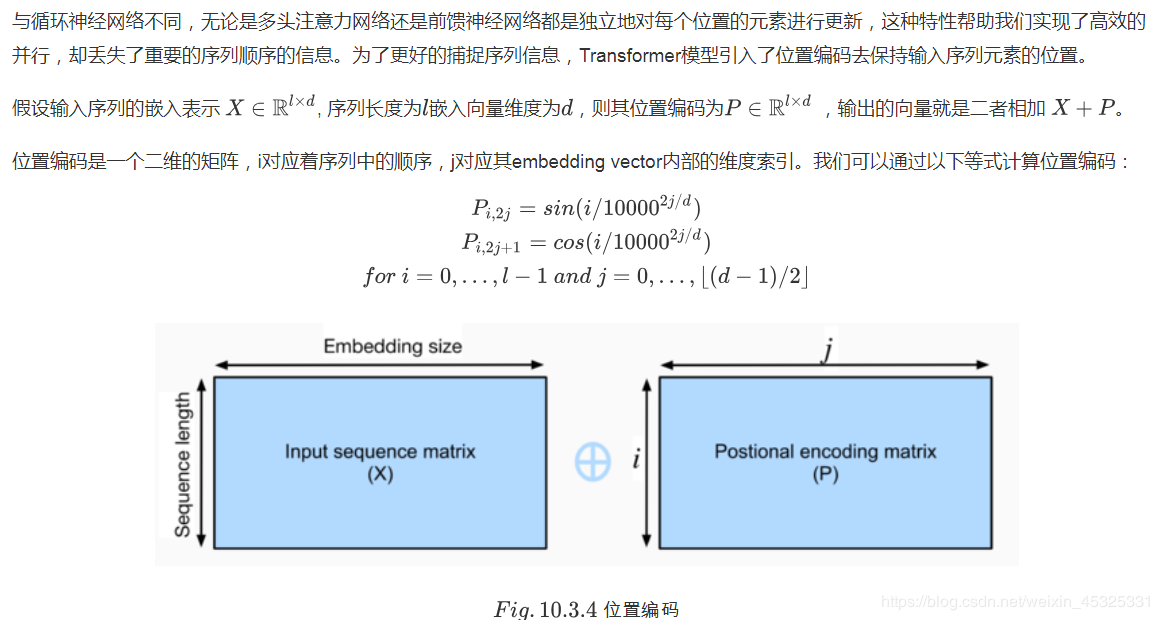
class PositionalEncoding(nn.Module):
def __init__(self, embedding_size, dropout, max_len=1000):
super(PositionalEncoding, self).__init__()
self.dropout = nn.Dropout(dropout)
self.P = np.zeros((1, max_len, embedding_size))
X = np.arange(0, max_len).reshape(-1, 1) / np.power(
10000, np.arange(0, embedding_size, 2)/embedding_size)
self.P[:, :, 0::2] = np.sin(X)
self.P[:, :, 1::2] = np.cos(X)
self.P = torch.FloatTensor(self.P)
def forward(self, X):
if X.is_cuda and not self.P.is_cuda:
self.P = self.P.cuda()
X = X + self.P[:, :X.shape[1], :]
return self.dropout(X)
编码器
我们已经有了组成Transformer的各个模块,现在我们可以开始搭建了!编码器包含一个多头注意力层,一个position-wise FFN,和两个 Add and Norm层。对于attention模型以及FFN模型,我们的输出维度都是与embedding维度一致的,这也是由于残差连接天生的特性导致的,因为我们要将前一层的输出与原始输入相加并归一化。
class EncoderBlock(nn.Module):
def __init__(self, embedding_size, ffn_hidden_size, num_heads,
dropout, **kwargs):
super(EncoderBlock, self).__init__(**kwargs)
self.attention = MultiHeadAttention(embedding_size, embedding_size, num_heads, dropout)
self.addnorm_1 = AddNorm(embedding_size, dropout)
self.ffn = PositionWiseFFN(embedding_size, ffn_hidden_size, embedding_size)
self.addnorm_2 = AddNorm(embedding_size, dropout)
def forward(self, X, valid_length):
Y = self.addnorm_1(X, self.attention(X, X, X, valid_length))
return self.addnorm_2(Y, self.ffn(Y))
现在我们来实现整个Transformer 编码器模型,整个编码器由n个刚刚定义的Encoder Block堆叠而成,因为残差连接的缘故,中间状态的维度始终与嵌入向量的维度d一致;同时注意到我们把嵌入向量乘以根号d 以防止其值过小。
class TransformerEncoder(d2l.Encoder):
def __init__(self, vocab_size, embedding_size, ffn_hidden_size,
num_heads, num_layers, dropout, **kwargs):
super(TransformerEncoder, self).__init__(**kwargs)
self.embedding_size = embedding_size
self.embed = nn.Embedding(vocab_size, embedding_size)
self.pos_encoding = PositionalEncoding(embedding_size, dropout)
self.blks = nn.ModuleList()
for i in range(num_layers):
self.blks.append(
EncoderBlock(embedding_size, ffn_hidden_size,
num_heads, dropout))
def forward(self, X, valid_length, *args):
X = self.pos_encoding(self.embed(X) * math.sqrt(self.embedding_size))
for blk in self.blks:
X = blk(X, valid_length)
return X
解码器
Transformer 模型的解码器与编码器结构类似,然而,除了之前介绍的几个模块之外,编码器部分有另一个子模块。该模块也是多头注意力层,接受编码器的输出作为key和value,decoder的状态作为query。与编码器部分相类似,解码器同样是使用了add and norm机制,用残差和层归一化将各个子层的输出相连。
仔细来讲,在第t个时间步,当前输入Xt是query,那么self attention接受了第t步以及前t-1步的所有输入。在训练时,由于第t位置的输入可以观测到全部的序列,这与预测阶段的情形项矛盾,所以我们要通过将第t个时间步所对应的可观测长度设置为t,以消除不需要看到的未来的信息。
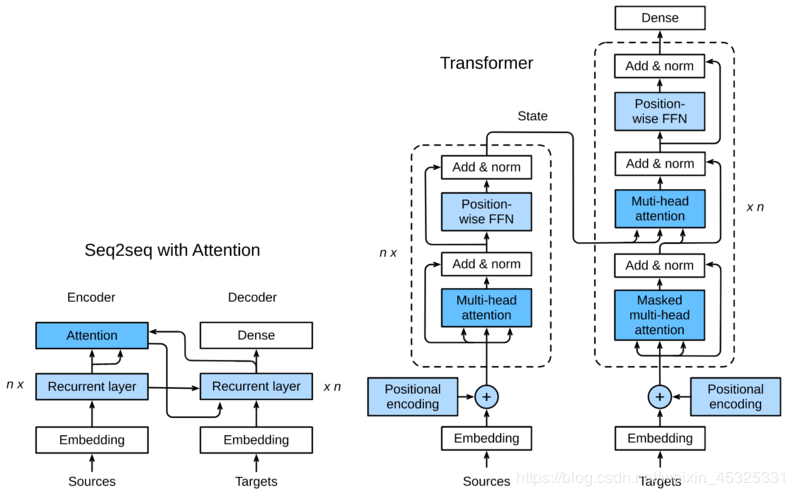
class DecoderBlock(nn.Module):
def __init__(self, embedding_size, ffn_hidden_size, num_heads,dropout,i,**kwargs):
super(DecoderBlock, self).__init__(**kwargs)
self.i = i
self.attention_1 = MultiHeadAttention(embedding_size, embedding_size, num_heads, dropout)
self.addnorm_1 = AddNorm(embedding_size, dropout)
self.attention_2 = MultiHeadAttention(embedding_size, embedding_size, num_heads, dropout)
self.addnorm_2 = AddNorm(embedding_size, dropout)
self.ffn = PositionWiseFFN(embedding_size, ffn_hidden_size, embedding_size)
self.addnorm_3 = AddNorm(embedding_size, dropout)
def forward(self, X, state):
enc_outputs, enc_valid_length = state[0], state[1]
# state[2][self.i] stores all the previous t-1 query state of layer-i
# len(state[2]) = num_layers
# If training:
# state[2] is useless.
# If predicting:
# In the t-th timestep:
# state[2][self.i].shape = (batch_size, t-1, hidden_size)
# Demo:
# love dogs ! [EOS]
# | | | |
# Transformer
# Decoder
# | | | |
# I love dogs !
if state[2][self.i] is None:
key_values = X
else:
# shape of key_values = (batch_size, t, hidden_size)
key_values = torch.cat((state[2][self.i], X), dim=1)
state[2][self.i] = key_values
if self.training:
batch_size, seq_len, _ = X.shape
# Shape: (batch_size, seq_len), the values in the j-th column are j+1
valid_length = torch.FloatTensor(np.tile(np.arange(1, seq_len+1), (batch_size, 1)))
valid_length = valid_length.to(X.device)
else:
valid_length = None
X2 = self.attention_1(X, key_values, key_values, valid_length)
Y = self.addnorm_1(X, X2)
Y2 = self.attention_2(Y, enc_outputs, enc_outputs, enc_valid_length)
Z = self.addnorm_2(Y, Y2)
return self.addnorm_3(Z, self.ffn(Z)), state
对于Transformer解码器来说,构造方式与编码器一样,除了最后一层添加一个dense layer以获得输出的置信度分数。下面让我们来实现一下Transformer Decoder,除了常规的超参数例如vocab_size embedding_size 之外,解码器还需要编码器的输出 enc_outputs 和句子有效长度 enc_valid_length。
class TransformerDecoder(d2l.Decoder):
def __init__(self, vocab_size, embedding_size, ffn_hidden_size,
num_heads, num_layers, dropout, **kwargs):
super(TransformerDecoder, self).__init__(**kwargs)
self.embedding_size = embedding_size
self.num_layers = num_layers
self.embed = nn.Embedding(vocab_size, embedding_size)
self.pos_encoding = PositionalEncoding(embedding_size, dropout)
self.blks = nn.ModuleList()
for i in range(num_layers):
self.blks.append(
DecoderBlock(embedding_size, ffn_hidden_size, num_heads,
dropout, i))
self.dense = nn.Linear(embedding_size, vocab_size)
def init_state(self, enc_outputs, enc_valid_length, *args):
return [enc_outputs, enc_valid_length, [None]*self.num_layers]
def forward(self, X, state):
X = self.pos_encoding(self.embed(X) * math.sqrt(self.embedding_size))
for blk in self.blks:
X, state = blk(X, state)
return self.dense(X), state
训练
import zipfile
import torch
import requests
from io import BytesIO
from torch.utils import data
import sys
import collections
class Vocab(object): # This class is saved in d2l.
def __init__(self, tokens, min_freq=0, use_special_tokens=False):
# sort by frequency and token
counter = collections.Counter(tokens)
token_freqs = sorted(counter.items(), key=lambda x: x[0])
token_freqs.sort(key=lambda x: x[1], reverse=True)
if use_special_tokens:
# padding, begin of sentence, end of sentence, unknown
self.pad, self.bos, self.eos, self.unk = (0, 1, 2, 3)
tokens = ['', '', '', '']
else:
self.unk = 0
tokens = ['']
tokens += [token for token, freq in token_freqs if freq >= min_freq]
self.idx_to_token = []
self.token_to_idx = dict()
for token in tokens:
self.idx_to_token.append(token)
self.token_to_idx[token] = len(self.idx_to_token) - 1
def __len__(self):
return len(self.idx_to_token)
def __getitem__(self, tokens):
if not isinstance(tokens, (list, tuple)):
return self.token_to_idx.get(tokens, self.unk)
else:
return [self.__getitem__(token) for token in tokens]
def to_tokens(self, indices):
if not isinstance(indices, (list, tuple)):
return self.idx_to_token[indices]
else:
return [self.idx_to_token[index] for index in indices]
def load_data_nmt(batch_size, max_len, num_examples=1000):
"""Download an NMT dataset, return its vocabulary and data iterator."""
# Download and preprocess
def preprocess_raw(text):
text = text.replace('\u202f', ' ').replace('\xa0', ' ')
out = ''
for i, char in enumerate(text.lower()):
if char in (',', '!', '.') and text[i-1] != ' ':
out += ' '
out += char
return out
with open('/home/kesci/input/fraeng6506/fra.txt', 'r') as f:
raw_text = f.read()
text = preprocess_raw(raw_text)
# Tokenize
source, target = [], []
for i, line in enumerate(text.split('\n')):
if i >= num_examples:
break
parts = line.split('\t')
if len(parts) >= 2:
source.append(parts[0].split(' '))
target.append(parts[1].split(' '))
# Build vocab
def build_vocab(tokens):
tokens = [token for line in tokens for token in line]
return Vocab(tokens, min_freq=3, use_special_tokens=True)
src_vocab, tgt_vocab = build_vocab(source), build_vocab(target)
# Convert to index arrays
def pad(line, max_len, padding_token):
if len(line) > max_len:
return line[:max_len]
return line + [padding_token] * (max_len - len(line))
def build_array(lines, vocab, max_len, is_source):
lines = [vocab[line] for line in lines]
if not is_source:
lines = [[vocab.bos] + line + [vocab.eos] for line in lines]
array = torch.tensor([pad(line, max_len, vocab.pad) for line in lines])
valid_len = (array != vocab.pad).sum(1)
return array, valid_len
src_vocab, tgt_vocab = build_vocab(source), build_vocab(target)
src_array, src_valid_len = build_array(source, src_vocab, max_len, True)
tgt_array, tgt_valid_len = build_array(target, tgt_vocab, max_len, False)
train_data = data.TensorDataset(src_array, src_valid_len, tgt_array, tgt_valid_len)
train_iter = data.DataLoader(train_data, batch_size, shuffle=True)
return src_vocab, tgt_vocab, train_iter
import os
import d2l
# 平台暂时不支持gpu,现在会自动使用cpu训练,gpu可以用了之后会使用gpu来训练
os.environ["CUDA_VISIBLE_DEVICES"] = "1"
embed_size, embedding_size, num_layers, dropout = 32, 32, 2, 0.05
batch_size, num_steps = 64, 10
lr, num_epochs, ctx = 0.005, 250, d2l.try_gpu()
print(ctx)
num_hiddens, num_heads = 64, 4
src_vocab, tgt_vocab, train_iter = load_data_nmt(batch_size, num_steps)
encoder = TransformerEncoder(
len(src_vocab), embedding_size, num_hiddens, num_heads, num_layers,
dropout)
decoder = TransformerDecoder(
len(src_vocab), embedding_size, num_hiddens, num_heads, num_layers,
dropout)
model = d2l.EncoderDecoder(encoder, decoder)
d2l.train_s2s_ch9(model, train_iter, lr, num_epochs, ctx)
注:
本博客所有内容均参考伯禹学习平台动手学深度学习课程
作者:李明朔